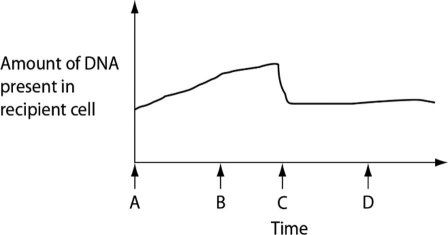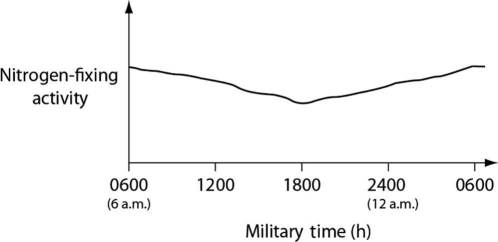Multiple Choice
Figure 24.2 depicts changes to the amount of DNA present in a recipient cell that is engaged in conjugation with an Hfr cell. Hfr cell DNA begins entering the recipient cell at time A. Assume that reciprocal crossing over occurs (in other words, a fragment of the recipient's chromosome is exchanged for a homologous fragment from the Hfr cell's DNA) . Use Figure 24.2 to answer the following question(s) .  Figure 24.2
Figure 24.2
-Data were collected from the heterocysts of a nitrogen-fixing cyanobacterium inhabiting equatorial ponds. Study the following figure and choose the most likely explanation for the shape of the curve.  Figure 24.3
Figure 24.3
A) Enough O₂ enters heterocysts during hours of peak photosynthesis to have a somewhat-inhibitory effect on nitrogen fixation.
B) Light-dependent reaction rates must be highest between 1800 hours and 0600 hours.
C) Atmospheric N2 levels increase at night because plants are no longer metabolizing this gas, so they are not absorbing this gas through their stomata.
D) Heterocyst walls become less permeable to N2 influx during darkness.
Correct Answer:

Verified
Correct Answer:
Verified
Q1: Bacteria participate in many ecological interactions. Which
Q8: In a hypothetical situation, a bacterium lives
Q10: Please use the following information to answer
Q11: Prokaryotes' essential genetic information is located in
Q17: The following table depicts characteristics of five
Q32: Figure 24.2 depicts changes to the amount
Q51: In general, what is the primary ecological
Q58: The following table depicts characteristics of five
Q72: Please use the following information to answer
Q95: Which of the following is likely the